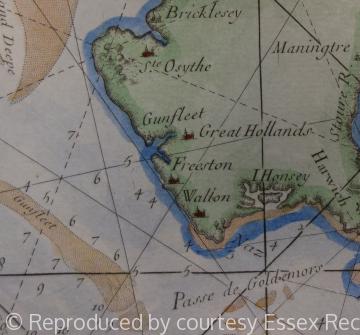The Gunfleet Sands and Channel

The Gunfleet sandbank lies off the coastline of Tendring district, directly opposite (east) of the entrance to the former Gunfleet estuary (also known as Gunfleet Haven or Holland Haven). Between the sandbank and the coast was a protected channel and anchorage, but the dangers of the sands have long been known to mariners and large numbers of vessels and their crews have been shipwrecked there over the centuries. From at least the 17th century the sands have been marked by buoys and also by a beacon or lighthouse. In recent years the Gunfleet Sandbank has been used as the site of an off-shore wind farm.
The name 'Gunfleet' was first recorded in 1318 when a vessel was shipwrecked on 'Gunfletsond', that is to say the Gunfleet Sands. In the reign of Henry VIII (1509-1542) the 'Gonflete' was also recorded as a sandbank, and a map of 1584 marks both the 'Gonflet Haven' (the estuary) and 'ye gonflit' (the sandbank). Thus the name of the estuary had clearly been appended to the sandbank that lay directly off the coast and opposite the estuary's inlet. The safer water between the sands and the inlet, now known as the Wallet, also seem to have been commonly known as the Gunfleet in the later 17th century when the English or Dutch fleets anchored there during the Dutch Wars. Similar uses of place-names including 'fleet' for coastal channels can be found elsewhere, a good example being the Fleet in Dorset, a long narrow channel separated from the English Channel by the major sandbank known as Chesil Bank.
As the former estuary was reclaimed for agriculture from the late 17th century onwards, so the original name was largely forgotten on land and replaced by the name Holland Haven. But off of the coastline the name has been preserved as the Gunfleet Sands into the 21st century.
Sources:
British Library, Ms cott. Aug. I.1, f. 44 (map, 1584).
Norden's map of Essex (1594).
P.H. Reaney, The Place-Names of Essex (1935), pp. 13-17.
Lt.-Co. A.R. Solly, 'Gunfleet - Haven, Anchorage and Sand', Essex Review, LX (1951), pp.203-06.
Content derived from research undertaken as part of the Victoria County History project



